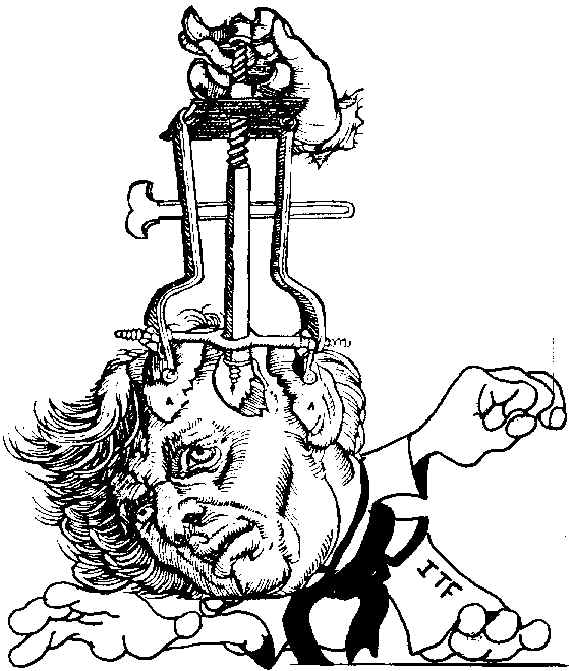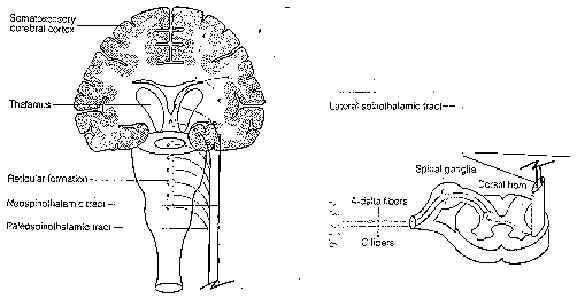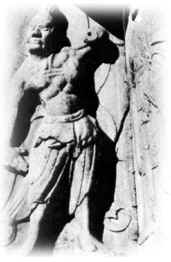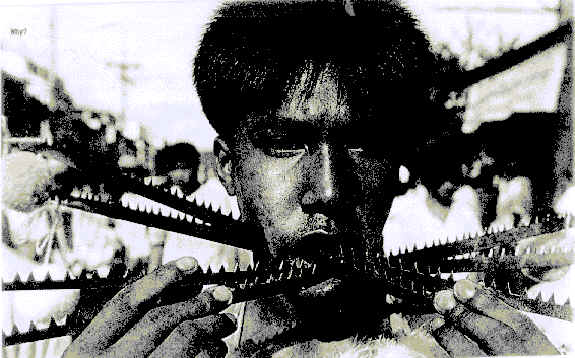

Imagine yourself standing in a do-jang at your III Dan Black Belt grading. You have just spent six months in preparation; all that hard work to realise your ultimate goal of passing to the III Dan level. Your grading is almost over, in front of you are the Black Belt Examiners of ITFNZ, around you are hundreds of people expecting you to perform, and it is your last break for destructions. All lined up, you hit your target with everything you've got ... and that puppy is still standing. Immediately there is an incredible soul-crushing sensation from your foot to your head. Tears could come splashing out of your eyes knowing that you have to experience that same feeling in your foot for your second attempt. Lining up your technique once more, all you can think is PAIN!
Pain is a great paradox. It can be creative and destructive, it can enable and embitter, it can protect and destroy. Pain can be a warning sign that something is wrong and yet can diminish the will to live or carry on with Taekwon-Do. It can be associated with survival and collapse - both saint and sinner pray to it.
Pain is a private personal experience common to all individuals yet unique to each. It suggests significantly different experiences to different people, both quality as well as quantity.
It is also extremely difficult to define on account of its complex interactions. It is also hard to agree within different people's minds whether or not it is a necessary experience in your Taekwon-Do training. During this thesis, if you choose to open your mind to one man's opinion, you may accept the need to push your body through those pain barriers, or you may totally disagree that it is a necessary part of your Taekwon-Do training.
As observers we can play no part in it for no-one can fully share the pain of another person; only the individual feels his or her pain. Picture yourself standing in a do-jang repeating pattern after pattern for hours on end, the pain mounting up not only mentally but physically, with fatigue, exhaustion, and stress. This is not dissimilar to conditioning your body by beating it - although it is felt differently, we must be able to accept them as the same feeling.
When our ancestors referred to pains and sorrows as, "God's vengeance upon sin" they were not necessarily attributing evil passions to God, they may have been recognising the good element in the idea of retribution.
Pain is an extremely complex state with both physical and psychological factors involved. What follows is an explanation of how our brain experiences the feelings of pain.
Pain results when nocireceptors (nerve endings or pain receptors) are stimulated by mechanical, thermal, or chemical factors. These stimuli are those that have the potential to cause tissue damage. The impulse is transmitted from the nociceptors to the spinal cord either along A-delta or C-delta fibres (Fig. 1).

Because they are covered with a sheath of insulating myelin, the A-delta fibres transmit powerful impulses quickly. C-delta fibres are small, unmyelinated fibres that transmit impulses more slowly. Impulses that are carried by the A-delta fibres are perceived as sharp, localised pain, such as a hit in the head during free sparring. Those impulses carried by the smaller C-delta fibres are perceived as a diffused, dull, aching pain, such as a slightly pulled hamstring after stretching incorrectly.
Nociceptive fibres enter the spinal cord through the dorsal horn, synapse in the spinal cord, and descend as the spinothalamis tract, which has two divisions: 1) the neospinothalamic tract which ascends to the thalamus and projects to the somatosensory cortex where it transmits information about the quality, intensity, and location of the offending pain stimulus; and 2) the paleospinothalamic tract, which occurs at many synapses, transmits impulses through the reticular system, and terminates in the thalamus, with projections to the limbic and subcortical areas. Once information is in these areas the brain acts as a complex electronic control unit, processing the data for a physical response.
Pain transmission is the key to the amount of pain a Taekwon-Do practitioner will experience at the moment of physical work or injury. The greater the intensity of stress, the more pain transmission. There is an extremely interesting factor that has a significant influence on pain transmission. Substance X (anything that induces pain) may increase the transmission of pain, whereas some tricky little chemicals produced by the body, namely endorphins and enkaphalins, decrease the release of substance X and inhibit the transmission of painful impulses.
The term "endorphin" is a combination of two words: endogenous and morphine. It means "morphine within". Research has shown that the human body manufactures its own supply of endorphins and enkephalins, another morphine-like substance. When the body releases these substances, one effect is pain relief.
Endorphins and enkephalins are peptides that are found in heavy concentrations in the central nervous system (see Figure 2). These substances relieve pain by the same mechanisms as morphine and other narcotics. They are thought to inhibit impulses that would be experienced as painful by blocking their transmission within the brain and spinal cord.
The existence of these substances in the body has several possible implications in clinical practice. First, it helps explain why different people feel different amounts of pain from the same stimuli. There are individual differences in endorphin levels as well as situational factors, such as anxiety which influences endorphin levels. People with more endorphins feel less pain, and vice versa (pain threshold). Second, certain techniques may relieve pain, at least in part because they cause the release of endorphins. Third, other methods pain relief, such as mental imagery, may help the Taekwon-Do practitioner release endorphins and thus inhibit pain transmissions.

With the ability of the body to produce more of this pain relieving drug, it would certainly be useful to build up a higher output level of endorphin and enkephalin release, during, say, a tournament fight. We will discuss this pain threshold later, and also see how one's threshold can be improved.
The perception of pain depends on the integrity of the nerve fibres that receive and transmit pain impulses and their central connections. There is a marked uniformity among people in the perception of pain. For example, if a full-contact turning kick were to be delivered to the solar plexus of 100 people, the amount of impact force necessary to cause pain would be similar in every case. However, individual responses would vary considerably.
The reaction to pain has physiological manifestations such as: high blood pressure, muscle tension, loss of appetite, vomiting, nausea, irritability, and restlessness. Behavioural responses will vary widely from one individual to another. His or her physical condition, emotional state, diet and sleep patterns and, most importantly, the way the practitioner has been conditioned to respond to the situation, will all influence their reaction.
The stage at which a noxious stimulus is perceived as pain, or "pain threshold", is primarily physiological, and depends on the duration of time and intensity of pain that a person accepts before making a verbal or overt response. This is influenced by psychological and sociocultural factors, and is an important factor in the practise of Taekwon-Do.
Pain thresholds can be divided into two different classes: high and low thresholds. Practitioners with neurotic disorders or, at least a lack of interest in conditioning themselves to pain, have a low pain threshold, and generally have a quicker breaking point.
Practitioners who subject themselves to an increasing amount of pain stimulus have an ability to withstand and push themselves further during the necessary times of painful experiences. Of course, there are a large number of factors relating to people's pain thresholds such as physical condition (fitness) and emotional state (attitude). Factors that lower pain threshold include: anxiety, fear, anger, depression, introversion, sympathy, and analgesics.
What is unbearable is not to suffer, but to be afraid of suffering. To endure a precise pain, a definite loss, a hunger for something one knows, this is possible to bear, and one can live with this pain. But, in fear there is all the suffering in the world; to dread suffering is to suffer an infinite pain since one supposes it unbearable!(Louis Evely, 1967)
Opinions differ over male and female domination in terms of who is the strongest. I will not take sides in this debate, as there are too many confounding factors, such as age, where the young are not as prepared as the old.
At some stage in Taekwon-Do training you will feel pain or be asked to endure pain in your career. To get an idea of what sort of pain may be awaiting us, it can be divided into two types: acute and chronic. Acute pain is relatively short-lived, and frequently adequately dealt with. It normally follows trauma and is experienced by everyone at some stage of their training; it could be anything from receiving an uncontrolled technique to exhaustion or fatigue from exercise. Chronic, or "intractable", pain presents rather a different picture. In contrast to acute pain, chronic pain generally means persistent pain, and can be disabling. Unfortunately chronic pain can be extremely severe - for example a damaged or torn muscle from showing off at a demonstration. Both types of pain can be quite disabling - the major question is what can you do about it?
Pain can be experienced from many sources during training, and there are various ways it can be fought through or relieved. One view is: "Pain is soul-destroying. No practitioners should have to endure intense pain unnecessarily, the quality of mercy is essential to the strain being endured in the mind." (Pain: an exploration). In reality as Taekwon-Do practitioners we must push through that psychological barrier. On the other hand, it is essential to repair injuries during training sensibly. Later, I shall mention methods of raising your pain threshold and conditioning your body to combat pain.
Relief of pain due to injury should really be essential. There are many ways to deal with an injury in Taekwon-Do. Firstly, you could seek advice from your doctor. Depending on the injury, there are different forms of pain relief.
One is drug therapy, but getting a doctor's advice on this is a good idea. Drugs which alleviate the tension, anxiety, and fear associated with responses to pain also have a place in treatment. It is generally agreed that most pain, no matter how severe, can be effectively relieved by narcotic analgesics. Since analgesics treat the symptoms only, it is important to fully evaluate the injury sustained. Where tension, anxiety, and fear are associated with practitioners' responses to pain, tranquillisers may be used in combination with both narcotics and narcotic analgesics; however in such cases seek medical advice.
Psychological procedures play an important part in pain therapy, particularly for those states which cannot be brought under satisfactory control by other methods.
Distraction:- Diversal procedures can often enhance the effects of pharmacological methods of pain relief. They are not attempts to help the patient forget about their pain, but rather to provide them with alternatives.Relaxation:- Relaxation reduces tension and thereby reduces pain.
Physical touch:- The use of touch to relieve discomfort and to heal has been acknowledged throughout the history of humankind, yet it is a somewhat neglected field.
Imagery: Imagery is a procedure employed to conjure up the most vivid possible picture or scene that is incompatible with pain.
Meditation:- Meditation involves achievement of deep relaxation, and the concentration of the attention on a single thought or theme. This is accompanied by a piece of mind and sense of well-being which neutralise stress and strain.
All of these methods can neutralise the effect of pain you feel from injury or physical stress whilst training. The most important is in the ATTITUDE to pain, i.e. pain threshold and the ability to build it. Pain threshold could be the one thing to see you through that grading; to have an endorphin level high enough to endure the pain.
With all the different types of pain that can be related to Taekwon-Do training, the main factors are "activity intolerance" and "fatigue". Activity intolerance can be defined as "a state in which a person has insufficient physical or psychological energy to endure or complete required training activity". The frequency, intensity, and duration that people are able to carry out their activities depends on a balance between available energy (oxygen and nutrients) and the energy that is required to complete the desired task.
Acute physical fatigue has a rapid onset and is perceived to be a normal response to a activity of high intensity and short duration. It serves as a protective mechanism, and is relieved when the activity ceases. Acute fatigue can develop when insufficient oxygen or nutrients are delivered to the muscle, and such muscle fatigue is associated with increased activity or exercise that is carried out to the point of exhaustion. Chronic fatigue differs from acute fatigue in terms of onset, intensity, perception, duration, and relief. This has a more gradual and insidious onset, and is typically perceived as being unusually intense for the amount of the activity performed. Chronic fatigue lasts longer than one month, and is not relieved by the cessation of activity. Fatigue in general can be very related to many other forms of pain we experience in Taekwon-Do.
We know that physical conditioning can influence the onset of pain. It is medically proven that physical conditioning, healthy diet, and correct amount of rest will increase the human pain tolerance level. Does everybody accept that conditioning can play an important role in the career of an ITF practising student? Some people in the art of Taekwon-Do remain pessimists about whether it can improve your ability to perform, but deep down inside they know it is a must.
"The study of Taekwon-Do offers several unique advantages to the physical fitness of the student. No doubt one of life's most treasured assets is good health. Therefore one of the great cardinal sins of mankind is his abuse of this asset. Incidentally, he who does not abuse or hurt his own body ... is defined as obedient to his parents; so described in Oriental philosophy."
('Taekwon-Do and Physical Fitness' in the Taekwon-Do condensed encyclopaedia)Surely this is related to avoiding injury, and is in contrast with what we usually see, hear and read in the popular media.
"By taking cold showers and baths, or exercising on snow-covered ground in bare feet, students build tenacity and pride."
('Cold Showers and Baths' in the Taekwon-Do condensed encyclopaedia)This says that there most certainly is room for pushing your mind and body beyond their normal limits. Figure 3 is a photo of the statue of Kumkang-Yuksa, a famous warrior in Sukulam, in a stone cave built in the age of the Silla Dynasty, with the following caption:
"Notice the similarities in form between the Kumkang-Yuksa and present day Taekwon-Do. The appearance of a clenched fist, a strong knifehand, and muscled legs which may have been the result of heavy training."
('Origin and Development of Martial Arts' in the Taekwon-Do condensed encyclopaedia)

This statement must say that there is nothing wrong with a good hard bit of conditioning with fitness and Taekwon-Do training. Surely it is up to the individual as to what sort of limit they are willing to approach.
The MIND is part of the barrier. In different countries many rituals are practised to induce pain. They say pain and religion have always gone hand in hand as surely as a good night out is followed by a blistering hangover. Most of these rituals are held in areas such as Phuket's annual Ngan Kin Jeh festival of purification, Wat Jui Tui Temple.
These festivals seems to serve a purpose of religion, but induce what should be incredible amounts of pain over their bodies. Face piercing and back stabbing are common (see Fig. 4) but the participants seem to feel no pain. So why do they do it? Some of them say the amount of pain-killing, opiate-like endorphins are under relentless assault, and they reach such enormous levels that they walk around feeling as high as junkies, often chanting "Chinese man feel no pain!". In South America, the Mandan tribe of Indians used to perform an initiation ritual called O-Kee-Pa, or the torture test, that was so gruesome it was amazing anyone ever managed to survive it.

In the Otago region of the South Island we have adopted a similar test, simply named the "Pain Weekend". This test is experienced by all members of the clubs wishing to sit a Dan grading, as part of their preparation. They are required to perform a ritual of driving to an area of wilderness and camping out. The first day involves fine-tuning their bodies in the great outdoors, while practising Taekwon-Do for approximately four hours. Lack of sleep and food are a required measure, and the next day involves two to three hours of gruelling torturous punishment, simply to enhance the mind for preparation for the black belt grading. In the grading if a large amount of fatigue sets in the student only has to remember the weekend, and the mind clears.
Remember, when relating pain with Taekwon-Do:
Indomitable Spirit (Baekjul Boolgool)
Confucious declared: "it is an act of cowardice to fail to speak out against injustice". As history has proven, those who have pursued their dreams earnestly and strenuously with indomitable spirit have never failed to achieve their goals.
The author would like to thank the special people for assisting me for all these years in the discovery of what the mind and body of a committed Taekwon-Do practitioner can achieve. Some of those special people and friends are: Jake Pearson, Sean Maguire, Kris Herbison, Lyndon Gold, Hayden Breese, James Buchan, John Morris, and my cat El Guapo.
